Today’s post is sponsored by CurrentBody! If you missed the first installment of our partnership, check it out here. For even more of my CurrentBody content, read this.
The most common question I get about LED masks is “do they actually work?” My answer is always “yes, if you use a high-quality LED mask consistently.” In fact, if you do that, I’m confident enough to say it is virtually impossible for it *not* to work—the science is just that legit. A bold statement indeed, but I’m prepared to back it up. This post will explore the science behind LED and why the CurrentBody Series 2 LED Mask is always my top recommendation.
A Brief History of LED Light Therapy
It’s reasonable to understand why one would question the ability of lights to help with wrinkles, until you think about what you already know to be true about lights. Different types of light have wide ranging effects, from sunburns to plant photosynthesis to curing gel manicures to impacting circadian rhythms. We know that light is capable of a lot of different things, but that not all light is capable of the same thing. That said, you’re not alone in thinking light therapy sounds too good to be true. When Danish physician Niels Ryberg Finsen was awarded the Nobel Prize in 1903 for his use of concentrated red light to treat sores, he didn’t quite understand why it worked either. It took a happy accident at NASA in the early 1990s to really start to understand what was going on.
NASA funded a team of scientists to develop an LED light system to grow plants in space (specifically potatoes for the 1995 space shuttle). Under the red and blue LEDs used to stimulate photosynthesis, the scientists noticed an interesting side effect on their exposed hands: their abrasions healed faster. They realized that LEDs could provide solutions to muscle atrophy and slow wound healing experienced by astronauts in space. The discovery kickstarted nearly a decade of NASA funded research into LED technology, which spawned even more research and clinical trials, eventually leading to the at-home application of LED devices used today.
For the purposes of this post, we’ll now be fast forwarding to the present, but you can read this summary of the full history if you’re interested.
The Science of LED Light Therapy
Thanks to NASA’s research and the subsequent work it inspired, we now have a body of evidence-based research that proves the effectiveness of LED light therapy and what, exactly, makes one device work better than another. There’s a lot more to it than just shining lights on your face.
Very simply, here’s how LED devices work:
Step 1: The lights emit photons (the smallest possible particle of light) into the skin.
Step 2: Photons are absorbed by cells, via structures called chromophores.
Step 3: The light absorption energizes cells and signals various processes or functions, such as collagen synthesis and cellular repair.
In order for those steps to occur, specific parameters need to be met:
The wavelength must be specific and precise. Different wavelengths penetrate to different depths in the skin and target different chromophores. The wavelength needs to be long enough to get where it needs to and precise enough to produce results at the target.
The irradiance (or power) must be the right strength. Once the wavelength hits the target, it must have enough photons (energy) to be absorbed to energize the cells. This is measured in mW/cm².
The dose (or treatment time) must be sufficient. The photons must be in contact with the target for long enough to make a difference.
In other words, the light needs to be targeted enough to reach where it needs to, powerful enough to stimulate what it’s supposed to and in contact for long enough to allow that stimulation to occur.
In addition to those scientific parameters, the skin coverage of a device can greatly impact the effectiveness:
LED placement: The bulbs need to be placed evenly across the face so that there are no gaps in coverage, which would result in uneven results and missed treatment areas.
Distance from the skin + fit: Well-fitting device = more light absorption = improved results. Gaps between the bulbs and the skin reduces the intensity as the light scatters and energy is lost. Clinical studies have demonstrated the importance of maximizing surface contact for optimal light penetration and uniform stimulation of skin cells. The flexibility/rigidity of a mask dictates how close of a fit you can get.
How the CurrentBody Series 2 Meets Those Parameters…and Then Some
Wavelength Precision: All types of light have their own wavelength, which can reach certain depths in the skin. Not all wavelengths have positive skin benefits and some may actually have negative impacts. A device must use specific wavelengths that can get the light where it needs to be.
The 2 wavelengths with the most clinical-evidence are red light (625-700nm) and near-infrared light (800-1200nm). These wavelengths help improve things such as fine lines & wrinkles, redness, skin evenness and laxity, as well as cellular repair and wound healing. Within the ranges, red light (633nm) and NIR (830nm) have specifically been shown to be the most effective. Each individual bulb needs to be as precise as possible (meaning close to the target wavelength) for optimal results. Variations in wavelength output leads to inconsistent and unreliable results, with some areas of the face receiving better treatment than others. In reality, there’s no way to guarantee the precision unless you test every single bulb.
The CurrentBody Series 2 uses both of the specific, evidence-based wavelengths of 633nm and 830nm, as well as deep NIR (1072nm), which has been demonstrated to target even deeper wrinkles, improve overall skin tone and firmness.
But what truly sets the mask apart is how each of the individual bulbs have an extremely high level of precision, with fluctuation as low as +/- 2nm (other higher-quality masks fall around +/- 10nm). To achieve this, CurrentBody created their own end-to-end production & testing system called Veritace®, which measures the precision of each individual bulb and mask. Every mask comes with its own Veritace® Card, which you can scan to trace your specific device through manufacturing and testing. It allows you to see:
The timestamped journey of each step in the manufacturing and quality control process
The results of spectroradiometer tests to measure the precise wavelengths and intensity
The results of technical reliability, performance and safety tests such as power output, battery capacity and electrical safety
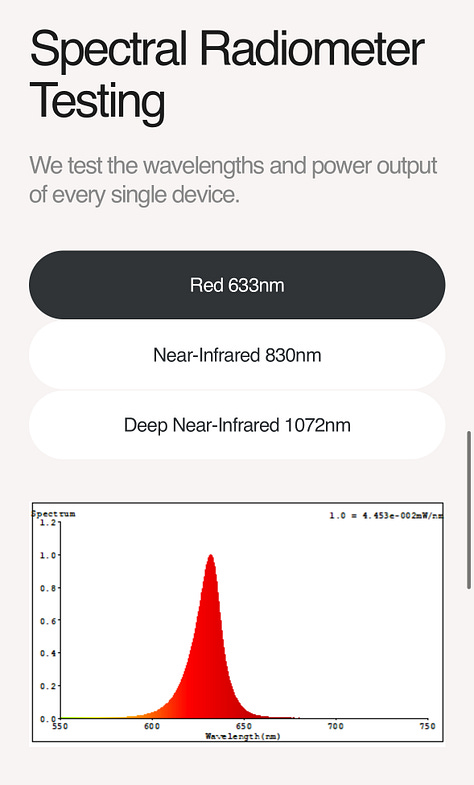


The video below shows CurrentBody’s LED Selection Machine! The precision of each individual bulb is tested to ensure each mask only gets the highest quality lights.
Irradiance & Dose: Though 2 separate parameters, they go hand in hand. In order for LED therapy to be effective, the power density (irradiance) needs to be delivered steadily and consistently for the optimal amount of time.
If the irradiance is too low, the device won’t be powerful enough to have any effects. Higher irradiance would mean a shorter treatment time, but overwhelming your skin with intensity is not correlated with better outcomes. If the irradiance is too high, aka too much energy is delivered, the photons will convert into heat before they reach the target, inhibit biological responses and/or cause cell damage. According to CurrentBody, dose control is critical—maintaining a lower energy density over a longer treatment time will give you improved results without overexposing the tissue. Think about baking a cake, there’s a reason you do 350° for 40 minutes and not 700° for 20.
Because the irradiance and dose are intertwined, there is no study that conclusively demonstrates the ideal irradiance and treatment time, but an irradiance of 30-50 mW/cm² is optimal. CurrentBody’s mask has an irradiance of 30 mW/cm² and 10-minute treatment time, based on multiple independent trials and CurrentBody’s own clinical testing which demonstrate significant improvement in skin quality with these conditions.
LED placement: The bulbs in the Series 2 are evenly distributed across the mask, ensuring every zone receives the same power. The mask has 236 bulbs, with added coverage in the eye, nose and mouth area, as well as a chin strap for under the jaw coverage! Since LEDs bulbs emit a 60° light spread and overlap, the bulbs are precisely spaced to optimize overlap and absorption beneath the skin, without overstimulation.
Distance from the skin + fit: The Series 2 is made from medical-grade poured liquid silicone to allow for a flexible, best-fit shape that evenly exposes your skin to the light. The silicone is soft and allows the mask to naturally curve to fit your face contours (as opposed to a sheet of medical-grade silicone that is cut out in the shape of a mask which will have gaps in coverage). The chin strap also improves coverage and fit. The mask comes with a multiway strap for the most secure and flush fit. I personally find the behind the head strap to be enough and don’t usually use the optional top of head strap. While it’s impossible to make a mask that perfectly fits every single person’s face (I look forward to the day I can get a mask that’s molded just for me) the CurrentBody is as close as you can get.
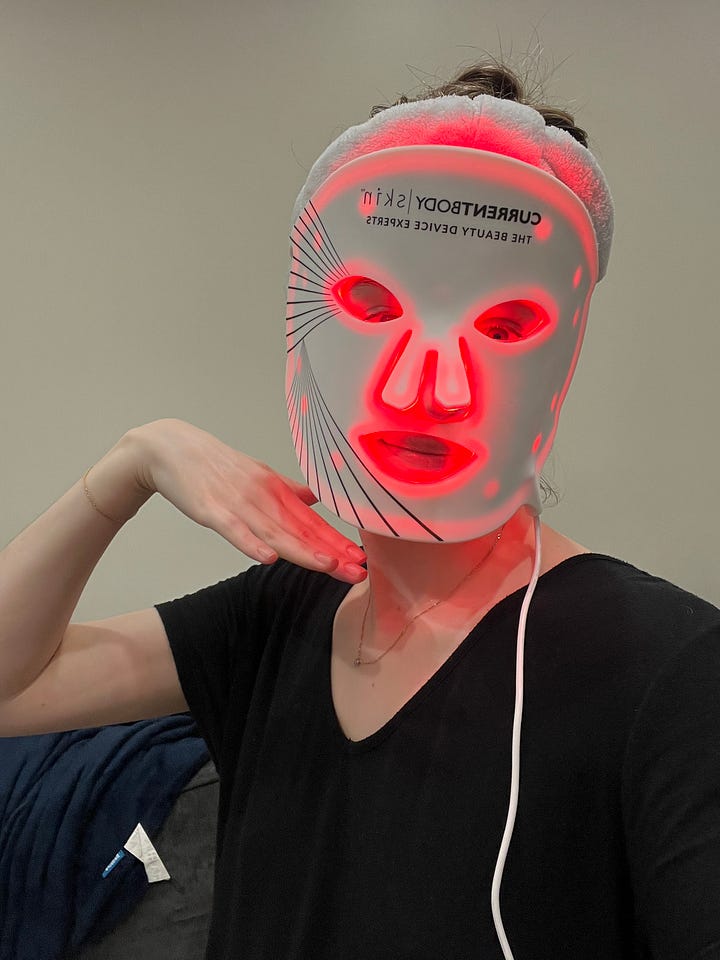
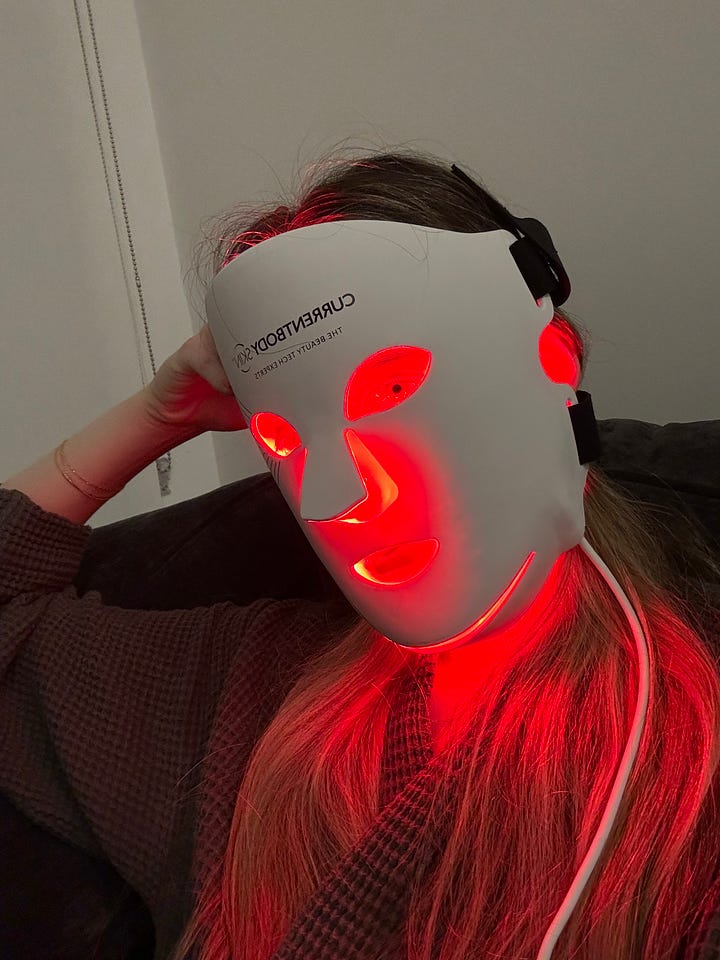
To really see the difference between CurrentBody’s design and their closest competitors, here’s a comparison of some of them side by side. In the spirit of fairness and transparency, CurrentBody even included their own Series 1 design in the mix. (The Series 1 was my top recommendation and in my opinion, the best option available, until the Series 2 was released.)
LED Myths & Misconceptions
Now that we know how LED therapy works and what makes CurrentBody’s Series 2 Mask stand out, let’s review some common misconceptions about LED masks.
More lights is always better. Not necessarily because more lights doesn’t always mean increased power. The wavelengths and irradiance matter much more than the number of lights themselves. A mask can have more lights with a lower power density (irradiance), producing little to no effect. Alternatively, a mask can have too many lights with a high power density, which can overstimulate and overheat the skin.
That said, the number of lights does make a difference in terms of even spacing and coverage. Too few lights and areas of the skin will be missed. A high-quality mask, like the Series 2, is designed to ensure optimal results through a balance of precise lights and evenly spaced placement.
More colors is better. We know that in order to even have a chance of benefitting the skin, the wavelength needs to reach deep enough for absorption to occur. Many brands will try to entice customers with a mask that has all sorts of pretty colored lights, but not all of those colors have long enough wavelengths. Wavelengths that are too short don’t penetrate the tissue deeply enough and scatter instead.
The most evidence-based wavelengths are red, near-infrared (NIR) and blue, with deep NIR more recently being clinically-supported. A high-quality mask will only use one or more of these demonstrated wavelengths. There is very little-to-no evidence demonstrating skin benefits from yellow or green light. In fact, green light actually has some evidence showing that it may cause hyperpigmentation. At best, these lights do nothing but take away space that could be filled with evidence-based wavelengths.
The blue light wavelength is a very unique case. It’s quite short (400-495nm) and only penetrates about 1mm into the skin (compared to red which is about 3mm), but at that depth it’s able to treat inflammatory acne by killing P. Acnes bacteria. Importantly, it’s specifically the 415nm wavelength that is shown to have that effect, as anything higher runs the risk of hyperpigmentation, especially on darker skin tones. Since blue light only helps with one aspect of acne (the bacteria), it’s best used in conjunction with red light, which can target the inflammation. Current Body’s Series 2 Anti-Acne LED Mask uses both lights at the optimal wavelengths. Additionally, blue light should only be used for short periods of time to minimize adverse effects. CurrentBody advises “using the device 3 to 5 times for 6 weeks to see best results. After 6 weeks of consecutive use, give your skin a short break of 1 to 2 weeks before resuming for another 6-week rotation.”
(For those reasons, unless you want to buy both, I generally recommend getting the regular Series 2 over the Anti-Acne version. That way, you’re getting the acne-benefitting effects of inflammation reduction, along with all of the other benefits and you can use the mask long-term.)
Shorter duration is better. While a shorter treatment time may be more convenient, remember that the duration goes hand in hand with irradiance. A shorter treatment time may mean a higher power density, making it more likely for the mask to get hot or have diminished effects (think about the cake analogy). Alternatively, if the power density is too low with the shorter treatment time, it may not deliver enough power to the skin to have effects.
Masks vs. handheld devices. Handheld devices are more affordable and may seem less laborious upfront, but in order to treat your entire face, you’d have to move and hold the device over every section. That would take an extremely long time and almost guarantee missed spots. (Also, the Series 2 battery pack has a clip and you can easily move around.) Handheld devices are good options for spot treatments, like those with blue (and ideally red) light, which you can use just on the areas that need it.
All of the above is what gives me enough confidence to say that if you use CurrentBody’s Series 2 LED Mask 3-5 times a week, it’s pretty much impossible to not see the difference in your skin. With that, I rest my case.
Use code JOLIECB at checkout for 10% off site wide on CurrentBody’s website.
Have a great week!
xx,
Jolie





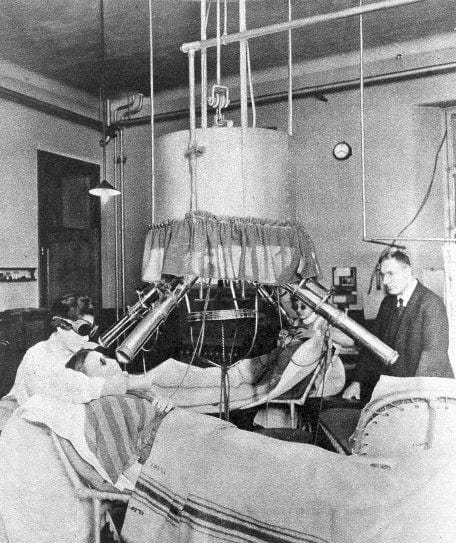
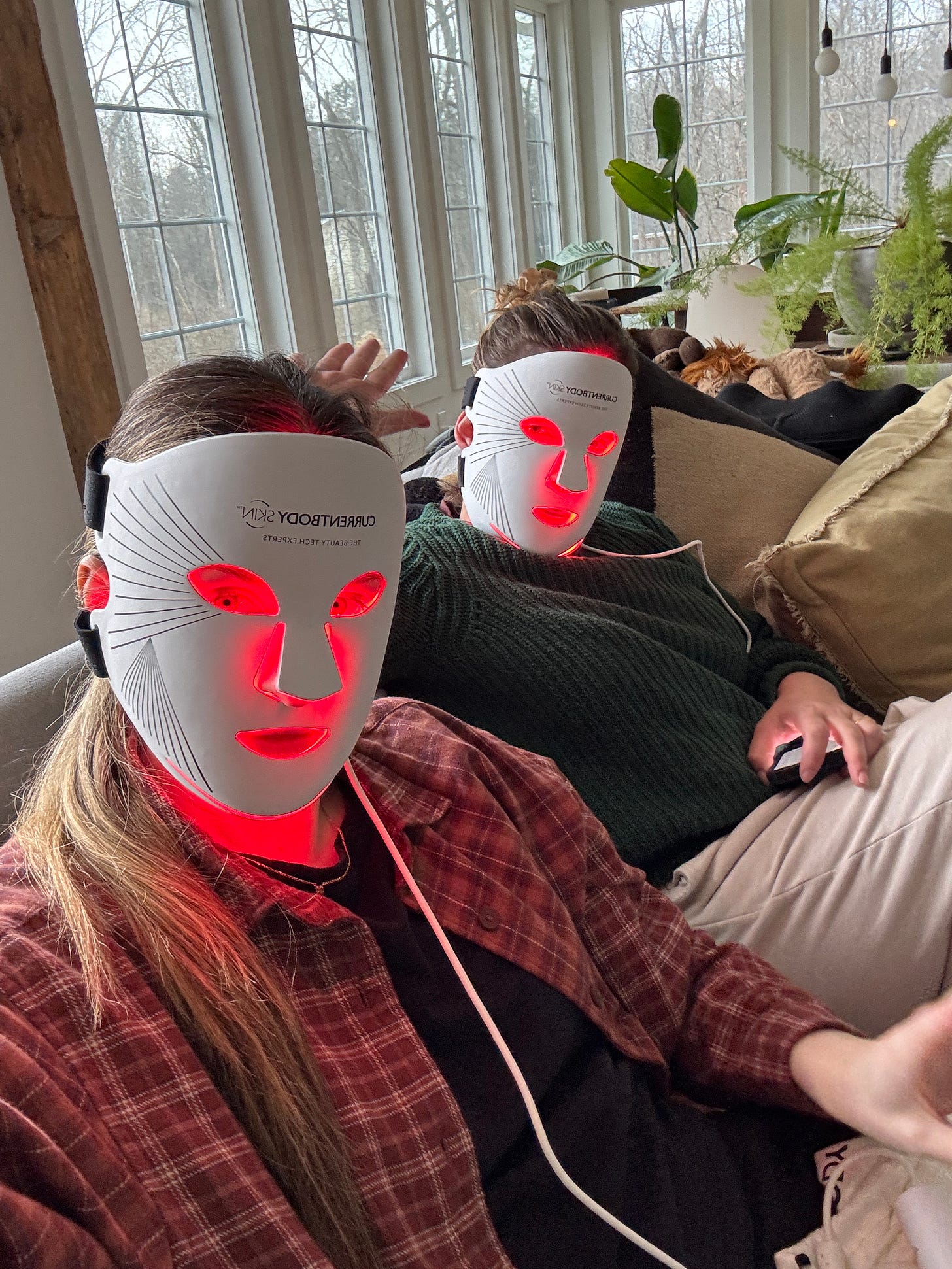




After about 6 months of using my mask I am definitely seeing reduction in fine lines (and general glowy-ness much sooner than that) but what I love is that is signals my “wind-down” time at night. Cleanse, red light mask, nighttime routine, reading, bed! ☺️
I was already wanting to upgrade my series 1 and this post proved the point. per usual, LOVE the depth of detail you get into Jolie!